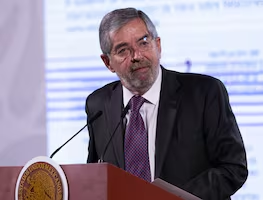Más Información

Posibles deportaciones masivas requieren acciones inmediatas: PRI; reducción de presupuesto del INM agrava situación

Diputada de MC propone despenalizar sustancias psicoactivas; cobrar impuestos al mercado de drogas recaudaría más de 1 bdp, calcula

Analizan reunión de cancilleres para enero; buscan coordinar estrategias antes posibles deportaciones masivas

Sheinbaum: se trabaja para que migrantes puedan acceder a programas del bienestar; colaboran Segob y consulados
The northern Mexico prison where authorities suddenly transferred convicted drug lord Joaquín "El Chapo" Guzmán is rated as the worst in the federal penitentiary system by human rights officials.
A 2015 report by the governmental National Human Rights Commission gave the Cefereso No. 9 in Ciudad Juárez, which borders Texas, a 6.63 rating on a scale of 0 to 10. That's the lowest for any of Mexico's 21 federal prisons.
By comparison, the maximum-security Altiplano facility where Guzmán was confined before was 10th best with a rating of 7.32.
However the Cefereso No. 9 scored well on "conditions of governability," perhaps an indication that authorities believe they can control Guzmán's environment there and reduce the risk of him pulling off a third brazen jailbreak.
The Sinaloa cartel boss, who is fighting to stave off extradition to the United States where he faces drug charges in seven different jurisdictions, was transferred in the pre-dawn hours Saturday in a surprise, high-security operation.
Mexican authorities called it part of a routine policy to rotate inmates for security reasons, though analysts said officials may also have wanted to shake up his environment to thwart any escape plans that could have been in the works.
According to the rights commission's report, the Cefereso No. 9 got low marks for guaranteeing a "dignified" stay and for handling inmates with special requirements. It got middling scores for guaranteeing prisoners' safety and well-being, and for rehabilitation.
It was also listed as somewhat overcrowded, with 1,012 inmates living in a facility with a designed capacity of 848. Authorities acknowledge that overcrowding is a widespread problem throughout Mexico's penitentiary system.
Overall the Cefereso No. 9 got a "yellow" evaluation for 2015 on the report's stoplight-style rating system. That was improved from "red" in 2014, even if its numerical score was still the country's lowest.
"El Chapo" first broke out of a Mexican prison in 2001 and spent more than a decade on the run. He was recaptured in 2014, only to escape the Altiplano lockup the following year through a mile-long tunnel dug to the floor of the shower stall in his cell.
Mexican marines re-arrested him in the western state of Sinaloa in January, after he fled a safe house through a storm drain.
Guzmán was returned to Altiplano, where officials beefed up his security regimen. He was placed under constant observation from a ceiling camera with no blind spots, and the floors of top-security cells were reinforced with metal bars and a 16-inch (40-centimeter) layer of concrete. Prison authorities also restricted his visits.
A lawyer for Guzmán confirmed Saturday that his defense continues to fight extradition, and Mexican officials have said the process could take months or up to a year to reach a final ruling.






